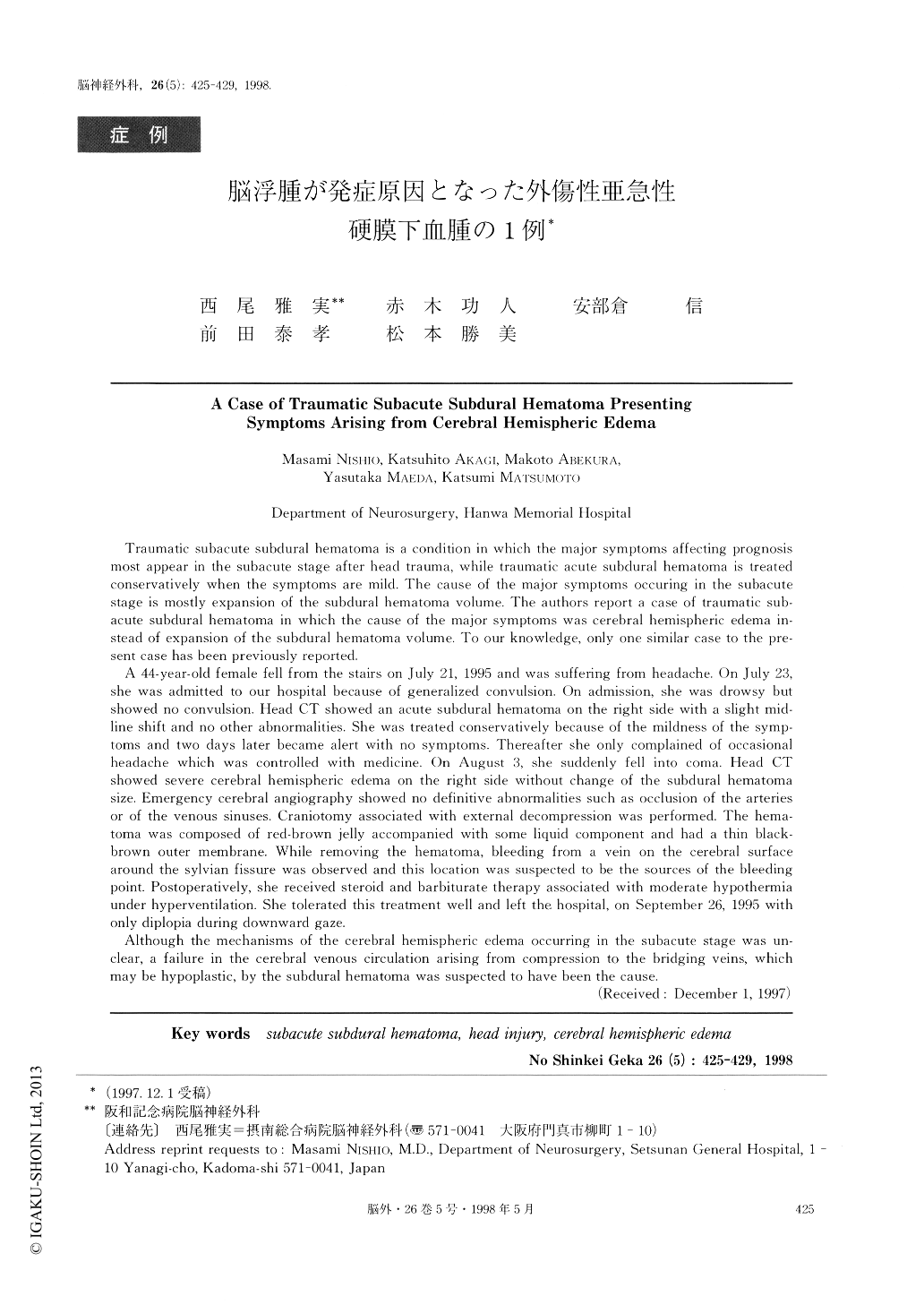Japanese
English
- 有料閲覧
- Abstract 文献概要
- 1ページ目 Look Inside
I.はじめに
外傷性亜急性硬膜下血腫は,受傷後の急性硬膜下血腫による症状が軽度で保存的治療をされているうちに,亜急性期に最も予後に影響する症状が出現したり,神経症状が悪化したりする硬膜下血腫とされており4,8,11),その亜急性期における発症原因は,森永ら11),唐澤ら4)によると硬膜下血腫部の増大による脳への圧迫の増強と考えられている.一方,この発症原因に関して,硬膜下血腫部の増大ではなく,同側の大脳半球の浮腫が発症原因となった本疾患が1例報告されている2).われわれも,血腫側の大脳半球浮腫が発症原因となり,緊急開頭外減圧術によく反応した症例を経験し,本疾患の病態と手術法を考える上で興味ある症例と考えられたので若干の文献的考察を加えて報告する.
Traumatic subacute subdural hematoma is a condition in which the major symptoms affecting prognosismost appear in the subacute stage after head trauma, while traumatic acute subdural hematoma is treatedconservatively when the symptoms are mild. The cause of the major symptoms occuring in the subacutestage is mostly expansion of the subdural hematoma volume. The authors report a case of traumatic sub-acute subdural hematoma in which the cause of the major symptoms was cerebral hemispheric edema in-stead of expansion of the subdural hematoma volume. To our knowledge, only one similar case to the pre-sent case has been previously reported.
A 44-year-old female fell from the stairs on July 21, 1995 and was suffering from headache. on July 23,she was admitted to our hospital because of generalized convulsion. On admission, she was drowsy butshowed no convulsion. Head CT showed an acute subclural hematoma on the right side with a slight mid-line shift and no other abnormalities. She was treated conservatively because of the mildness of the symp-toms and two days later became alert with no symptoms. Thereafter she only complained of occasionalheadache which was controlled with medicine. On August 3, she suddenly fell into coma. Head CTshowed severe cerebral hemispheric edema on the right side without change of the subclural hematomasize. Emergency cerebral angiography showed no definitive abnormalities such as occlusion of the arteriesor of the venous sinuses. Craniotomy associated with external decompression was performed. The hema-toma was composed of red-brown jelly accompanied with some liquid component and had a thin black-brown outer membrane. While removing the hematoma, bleeding from a vein on the cerebral surfacearound the sylvian fissure was observed and this location was suspected to be the sources of the bleedingpoint. Postoperatively, she received steroid and barbiturate therapy associated with moderate hypothermiaunder hyperventilation. She tolerated this treatment well and left the hospital, on September 26, 1995 withonly diplopia during downward gaze.
Although the mechanisms of the cerebral hemispheric edema occurring in the subacute stage was un-clear, a failure in the cerebral venous circulation arising from compression to the bridging veins, whichmay be hypoplastic, by the subdural hematoma was suspected to have been the cause.

Copyright © 1998, Igaku-Shoin Ltd. All rights reserved.


